Related Research Articles
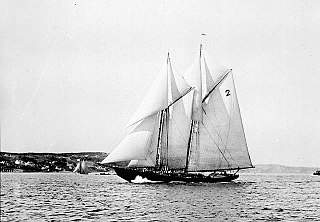
Bluenose was a fishing and racing gaff rig schooner built in 1921 in Lunenburg, Nova Scotia, Canada. A celebrated racing ship and fishing vessel, Bluenose under the command of Angus Walters, became a provincial icon for Nova Scotia and an important Canadian symbol in the 1930s, serving as a working vessel until she was wrecked in 1946. Nicknamed the "Queen of the North Atlantic", she was later commemorated by a replica, Bluenose II, built in 1963. The name Bluenose originated as a nickname for Nova Scotians from as early as the late 18th century.
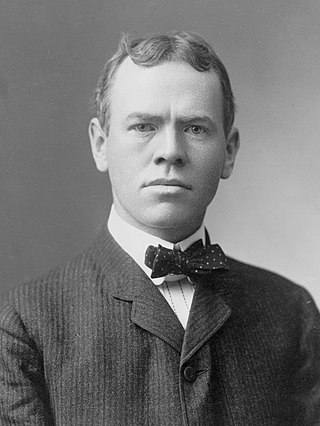
James Brendan Bennet Connolly was an American athlete and author. In 1896, he was the first modern Olympic champion.

Liverpool is a Canadian community and former town located along the Atlantic Ocean of the Province of Nova Scotia's South Shore. It is situated within the Region of Queens Municipality which is the local governmental unit that comprises all of Queens County, Nova Scotia.

Canso is a community in Guysborough County, on the north-eastern tip of mainland Nova Scotia, Canada, next to Chedabucto Bay. In January 2012, it ceased to be a separate town and as of July 2012 was amalgamated into the Municipality of the District of Guysborough.
The first USS Lee was a schooner under the Continental Army during the American Revolutionary War. She was named for General Charles Lee.

Riverport is a village in Lunenburg County, Nova Scotia, Canada. The harbour of Ritcey Cove is free from shoals and safe from every wind, considered one of the finest in North America. Riverport is a five-minute drive to several public beaches including Hirtle's Beach, Kingsburg Beach, Oxner Beach, Rose Bay Beach and Spindler Beach.

Bluenose II is a replica of the fishing and racing schooner Bluenose, commissioned by Sidney Culverwell Oland and built in 1963 as a promotional yacht for Oland Brewery. Sidney Oland donated the schooner to Nova Scotia in 1971 and it has since operated as a sailing ambassador and promotional device for Nova Scotia tourism. In honour of her predecessor's record, Bluenose II does not officially race.

Effie M. Morrissey is a schooner skippered by Robert Bartlett that made many scientific expeditions to the Arctic, sponsored by American museums, the Explorers Club and the National Geographic Society. She also helped survey the Arctic for the United States Government during World War II. She is currently designated by the United States Department of the Interior as a National Historic Landmark as part of the New Bedford Whaling National Historical Park. She is the State Ship of Massachusetts.
The Esperanto was a fishing schooner based in Gloucester, Massachusetts.
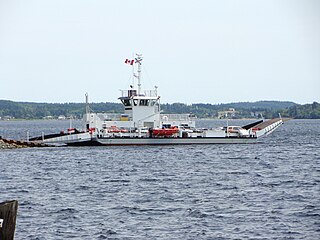
The LaHave River is a 97 km (60 mi) river in Nova Scotia, Canada, running from its source in Annapolis County to the Atlantic Ocean. Along its way, it splits the communities of LaHave and Riverport and runs along the Fairhaven Peninsula and bisects the town of Bridgewater flowing into the LaHave River estuary. Tides affect water levels for about 20 km up the river. There are a number of tourist attractions along the river, and it is also well-used for recreational sailing. As well as two bridges at Bridgewater, the river can be crossed by a cable ferry at the Community of LaHave.
Martin Leander Welch (1864–1935) was a fishing schooner captain out of Gloucester, Massachusetts. He was captain of the Esperanto in 1920 when it defeated the Canadian schooner Delawana in the first International Fishing Schooner Championship Races in Halifax, Nova Scotia.
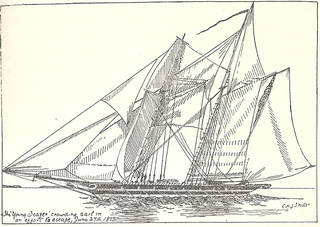
Young Teazer was a United States privateer schooner that captured 12 British vessels, five of which made it to American ports. A member of her crew blew her up at Mahone Bay, Nova Scotia during the War of 1812 after a series of British warships chased her and after HMS Hogue trapped her. The schooner became famous for this deadly explosion, which killed most of her crew, and for the folklore about the ghostly "Teazer Light."

Jeddore is a Canadian rural community in Nova Scotia's Halifax Regional Municipality. The community itself comprises several smaller communities. Often the inner communities are referred to on their own but much of the time simply the encapsulating region of Jeddore is simply used. This is most likely due to the size of the communities, individually they are relatively unknown to residents outside of Nova Scotia's Eastern Shore.

Gertrude L. Thebaud was an American fishing and racing schooner built and launched in Essex, Massachusetts in 1930. A celebrated racing competitor of the Canadian Bluenose, it was designed by Frank Paine and built by Arthur D. Story for Louis A. Thebaud, and named for his wife, Gertrude Thebaud. In their first meeting at Gloucester, Massachusetts in October 1930, Gertrude L. Thebaud bested Bluenose 2-0 to win the Sir Thomas Lipton International Fishing Challenge Cup. However, in 1931, two races to none, and again in 1938, three races to two, Bluenose defeated Gertrude L. Thebaud to remain the undefeated holder of the International Fisherman's Trophy. During World War II, the schooner saw service with the United States Coast Guard. The vessel sank in 1948 off the coast of Venezuela.

Angus James Walters was a sailor and sea captain who skippered Bluenose from 1921 to 1938. Walters captained Bluenose to five international sailing races, and was undefeated for seventeen years.

Sherman Zwicker is a wooden auxiliary fishing schooner built in 1942 at the Smith and Rhuland shipyard, Lunenburg, Nova Scotia. Influenced by the design of the famous Bluenose, Sherman Zwicker was built to fish the Grand Banks. The schooner was built for F. Homer Zwicker of Zwicker and Co. Officially christened in 1942, the F/V Sherman Zwicker is the last operable saltbank fishing vessel in existence.
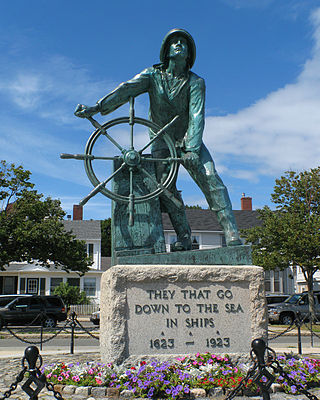
Richard Moses Murphy (1838–1916) was a well-known schooner captain who sailed out of Gloucester, Massachusetts, during the late 1800s. Some of his experiences as a mariner are detailed in a chapter titled "The Adventures of Captain Richard Murphy" in The Fisherman’s Own Book, published by Proctor Brothers in 1882.
The FV Flora Alberta was a Canadian auxiliary fishing schooner based out of Lunenburg, Nova Scotia. She was launched in 1941 by Smith and Rhuland, the company's 187th vessel. The managing owner of the vessel was fishing company Adams & Knickle.

The Battle of Blomidon took place on 21 May 1781 during the American Revolutionary War. The naval battle involved three armed U.S. privateer vessels against three Nova Scotian vessels off Cape Split, Nova Scotia. American Privateers caught two Nova Scotia Vessels. The first Nova Scotia vessel was re-captured by Lieut Benjamin Belcher. The second Nova Scotia vessel was overtaken by the captured crew under the command of Captain Bishop. The privateers were taken to Cornwallis and put on trial.
The Columbia was an American schooner, a fishing vessel launched in 1923. She took part in several races, and subsequently disappeared off Nova Scotia in 1927. A replica was built in 2014.
References
- Yankee Magazine, "We're Off To Win The Cup!", Irene M. Patten, September 1969
- Collier's Weekly, "The Flying Gloucesterman", James B. Connolly, December 25 1920